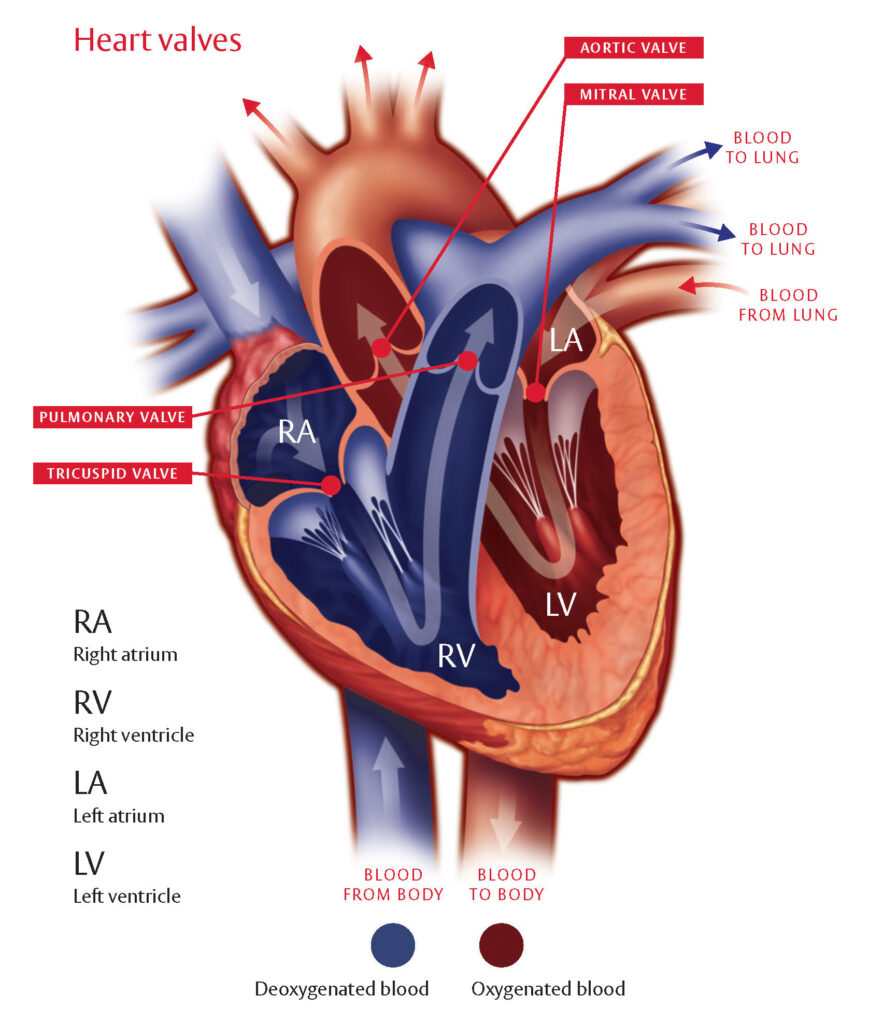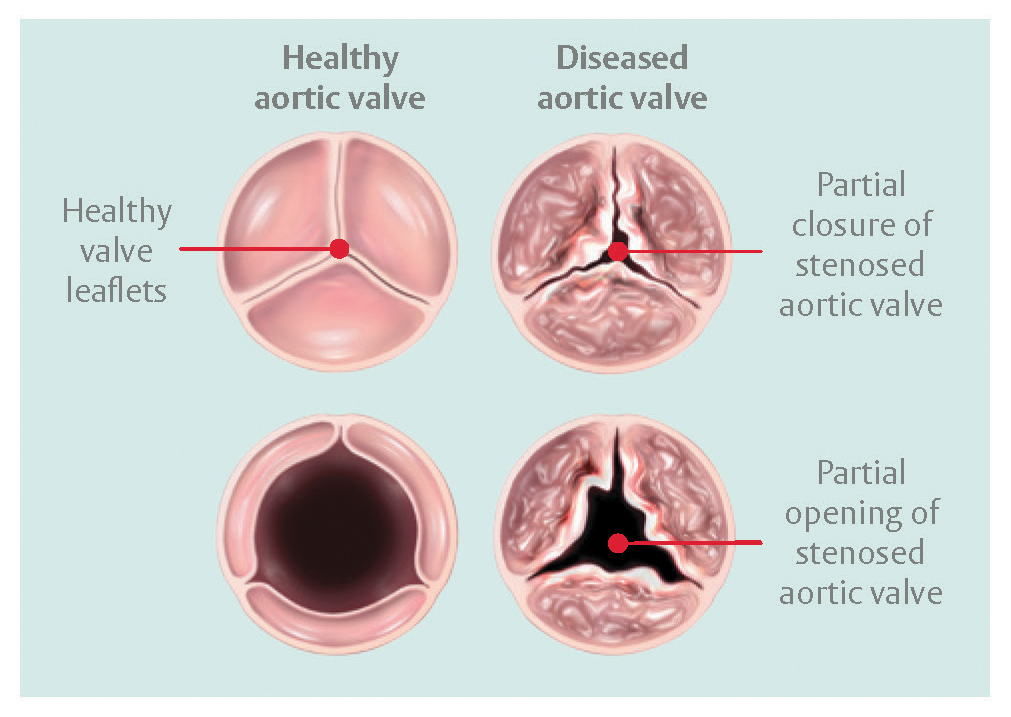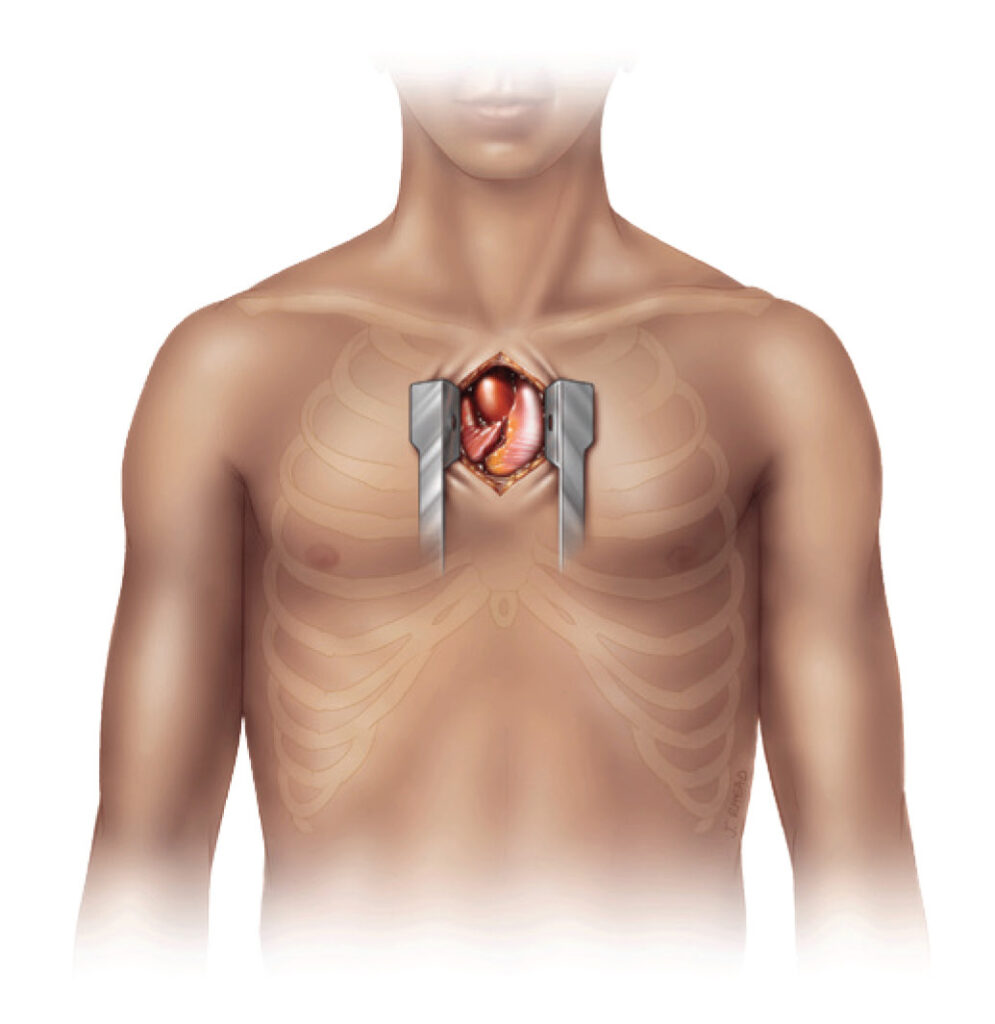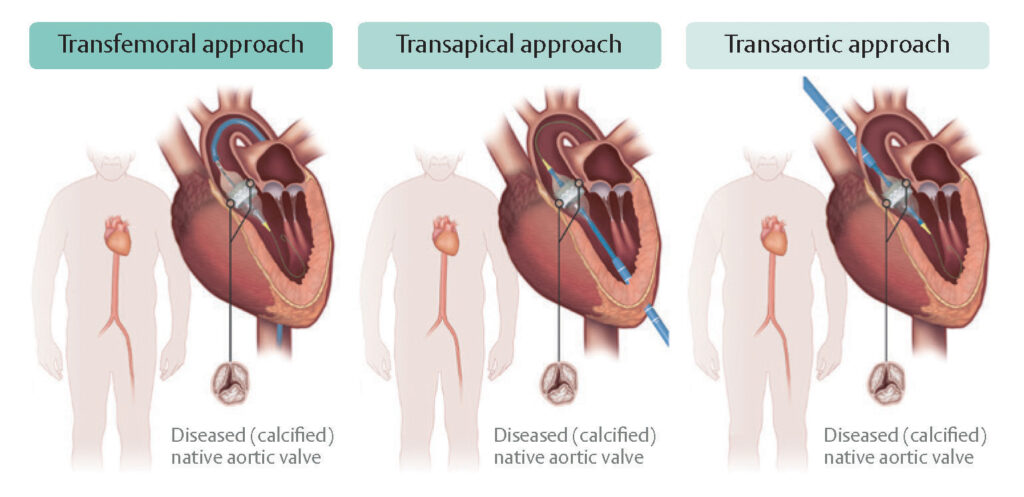Aortic Stenosis Anatomy Diagnosis Treatment

How does the heart work normally?
To help answer my questions, my cardiologist explained how the heart normally works. He specifically focused on how the aortic valve operates, as he thought this might be the cause of my problems.

Structure
The heart is made up of four chambers, called atria and ventricles – one atrium and one ventricle on the right, which pump blood to the lungs, and one atrium and one ventricle on the left, which pump blood around the rest of the body.
Blood circulation
On each side of the heart, the atrium and ventricle are separated by a valve. Blood is pumped through the right atrium and ventricle and out of the heart through the pulmonary valve, then on to the lungs to be oxygenated. This blood then returns to the left side of the heart. It is then pumped through the aortic valve into the main artery (the aorta) and around the body.
The aortic valve
The essential function of a heart valve is to maintain the flow of blood in the right direction. When the left ventricle has contracted fully and pumped the oxygenated blood into the aorta, the aortic valve closes. It only opens again when the ventricle has refilled blood from the left atrium, ready for the next contraction.
Now that I understood how important the aortic valve is, my cardiologist talked to me about aortic stenosis.

Diagnosis and treatment
General Cardiologist = The cardiologist will perform some more tests on your heart to decide which of your heart valves is not working well. This will help to determine what is causing your heart murmur. You will also be able to discuss the different treatment options available with the cardiologist..
Heart Team = If it is necessary, your cardiologist will refer you to the heart team. This multidisciplinary
team of specialists will discuss the most suitable options of intervention with you.

What is aortic stenosis?
In a patient with aortic stenosis, the aortic valve no longer opens fully. Its opening is restricted as the leaflets of the valve become stenosed (narrowed) over time. This makes it harder for your heart to pump blood through the valve and around your body. The narrower the valve, the harder the heart has to work and the worse the symptoms are likely to be. As my heart was having to work a lot harder, this explained why I often feel out of breath and dizzy. My cardiologist explained that if this carried on for a long time, then my symptoms may become worse and I could eventually develop heart failure. People with severe aortic stenosis may also suffer from fainting, and in some cases it can lead to the heart stopping completely. So, I had grasped what aortic stenosis was and why it was happening. My next question was “can something be done to fix this?” The answer to which was “yes”.

What are the treatment options for aortic stenosis?
My cardiologist explained that in severe aortic stenosis, there are two treatment options. Rather than controlling the symptoms of the condition, these actually replace the function of the narrow valve. These options comprise surgical aortic valve replacement and transcatheter aortic valve implantation.
Surgical aortic valve replacement is a form of open-heart surgery. For this, I would need to have a general anaesthetic so that I am asleep when the doctors open up my chest and put a new valve in place of my narrowed valve, allowing my heart to work normally again. This is a very well-established treatment that has been used successfully for many years.
Transcatheter aortic valve implantation, or TAVI for short, does not require open-heart surgery. Instead of opening my chest, a small incision is made, often in the groin, or sometimes the chest. Then a tube (catheter) is inserted into the artery and from there to the heart, or directly into the left ventricle. The replacement valve is passed through the catheter to the heart, then expanded within the faulty valve. As with surgical aortic valve replacement, the new valve allows my heart to work normally again.

My cardiologist has told me that both treatment options should improve my symptoms. I am now going to have an evaluation by the specialist heart team, and they will decide which of these options is best for me. Of course, we are all different, so I’m sure your cardiologist and the heart team will discuss the best intervention for you.

Get the help you need
So, rest assured that there are options and there is hope. Your cardiologist and the rest of the heart team are all dedicated to making you better. Learning this was a real reassurance for me, as I hope it is for you and your family too.
Key things to remember
- Aortic stenosis is a common form of heart valve disease
- Several different treatments are available for aortic stenosis
- Treatment can improve your symptoms giving you better quality of life
For more information please visit
References
1. Grimard BH, Larson JM. Aortic Stenosis: Diagnosis and Treatment. Am Fam Physician 2008;78:717–24.
2. Maganti K et al. Valvular Heart Disease: Diagnosis and Management. Mayo Clin Proc. 2010;85:483–500.
3. Carabello BA. Introduction to aortic stenosis. Circ Res 2013;113:179–85.
4. Conti V, Lick SD. Cardiac surgery in the elderly: indications and management options to optimize outcomes. Clin Geriatr Med 2006;22:559–74.
5. Sundt TM, Bailey MS, Moon MR et al. Quality of life after aortic valve replacement at the age of >80 years. Circulation 2000;102[suppl III]:70–74.
6. Chiappini B, Camurri N, Loforte A et al. Outcome after aortic valve replacement in octogenarians. Ann Thorac Surg 2004;78:85–9

